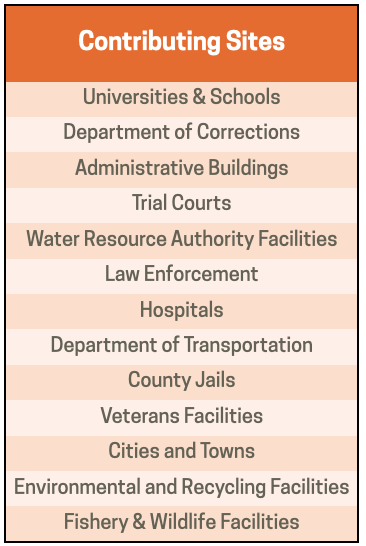How Can CPower Help You?
Over the last fifteen years, CPower has paid $8,752,924 to over 200 Massachusetts government entities that participate in demand response programs through DCAMM.
CPower is dedicated to providing each participating DCAMM organization with an exceptional customer experience. Regardless of your mission or facility type, CPower can help you:
Offset Rising Peak Demand Charges. Every month your organization is charged a fee by your electric utility—called a capacity charge or peak charge—based on how much electricity you consumed during the period when electricity demand was at its highest. If you can curtail your energy consumption during periods of peak system load, you will lower your capacity value (cap tag) which in turn will potentially reduce your power costs.

Fund Your Projects, Not Someone Else’s. Demand response participation gives you a repeatable revenue stream. Demand response with CPower ensures that the revenue stream flows right back to you—not to a general fund. You keep what you earn and can spend it on your own initiatives.
Enroll With The Push of a Button. DCAMM’s demand response program with CPower eliminates the lengthy, complicated, and time-consuming bidding process that can really slow things down. Sending a simple email is all it takes to get you quickly enrolled. The faster you enroll, the faster you start to save and earn.
Start the Conversation with CPower
Designated DCAMM Statewide Contract for Demand Response Services
view full contract here
This is a Statewide Contract for demand response (DR). Demand response is a temporary reduction or shift in a facility’s electricity use by switching to on-site emergency generators, load curtailment (temporarily turning off non-essential equipment) or other means during the hours when the electrical grid experiences peak demand (e.g. hot summer days). By participating in demand response programs, facilities help the electrical grid manage the increased demand for power during critical times and, in return, receive financial compensation for participation.
This contract enables Eligible Entities to access such financial incentives by engaging a contractor who will:
- Enroll and manage the participation of Eligible Entity facilities (hereinafter “Customer Assets”) in the ISO New England (ISO-NE) Demand Response Program, Utility Load Curtailment Programs, and Clean Peak programs as applicable. Provide support services for current and future assets enrolled and to be enrolled by the Commonwealth in the Forward Capacity Market.
- Generator Upgrades: Upgrade, retrofit or replace existing emergency generators in various locations throughout the Commonwealth.
The contractor must provide all equipment, devices, data collection, testing, and any additional products and/or services necessary to make all Customer Assets eligible and to enroll them in the above referenced programs. Furthermore, beginning with the Customer Asset’s enrollment in a DR Program, the contractor, will manage all aspects of participation in said Program, including but not limited to all obligation management, notification of appropriate Eligible Entity employees for events, and transfer of funds to the Eligible Entity. The Eligible Entity will be responsible for responding to event notifications, the reliability of their generators (if applicable) and the facility electrical systems.
Statewide contracts are an easy way to obtain benefits for your organization by leveraging the Commonwealth’s buying power, solicitation process, contracting expertise, vendor management and oversight, and the availability of environmentally preferable products.
Revenue Generating Contract – This contract is designed as a user-friendly way to bring Eligible Entities revenue for their participation in demand response programs.
No Upfront Cost – Eligible Entities do not incur any upfront cost for assessing the feasibility of their participation in the program or for enrolling in the program. The Contractor is responsible for those costs.
Reduction in Calculated Electricity Rates
Some utilities calculate the rates they charge customers based on their energy demand during peak hours. Participation in demand response programs during those hours reduces the facilities’ peak energy demand and, as a result, helps reduce the rates they pay for electricity throughout the year.
Applicable Procurement Law
Executive Branch Goods and Services: MGL c. 7, § 22; c. 30, § 51, § 52; 801 CMR 21.00;
Eligible Entities
Please see the standard list of Eligible Entities on our Who Can Use Statewide Contracts webpage.
01. Cities, towns, districts, counties and other political subdivisions
02. Executive, Legislative and Judicial Branches, including all Eligible Entities and elected offices therein;
03. Independent public authorities, commissions and quasi-public agencies
04. Local public libraries, public school districts and charter schools;
05. Public Hospitals, owned by the Commonwealth;
06. Public institutions of high education
07. Public purchasing cooperatives;
08. Non-profit, UFR-certified organizations that are doing business with the Commonwealth;
09. Other states and territories with no prior approval by the State Purchasing Agent required; and
10. Other entities when designated in writing by the State Purchasing Agent.
Eligible Entity Classification for This Contract
For the purpose of this contract, all Eligible Entities are divided into two groups based on their relationship with the Division of Capital Asset Management and Maintenance (DCAMM):
DCAMM Controlled
This includes Executive, Legislative and Judicial Branches, including all Departments and elected offices therein, and public hospitals owned by the Commonwealth. For all those Eligible Entities, DCAMM will serve as the point of contact for establishing initial communication, Customer Asset enrollment, and all payments. DCAMM authorization is required for the Contractor to enroll Customer Assets belonging to a DCAMM Controlled Eligible Entity.
Non-DCAMM Controlled
This includes all other Eligible Entities listed (e.g. cities, towns, public schools, etc.). Non-DCAMM Controlled Eligible Entities do not need to sign any agreement with DCAMM. They may engage the Contractor directly and must establish direct payment relationships with the Contractor.